I plan on trying to develop my own film (120 & 4x5), and after a bunch of research I have settled on Kodak's Flexicolor SM Tank chemicals. (Developer, Part 5283973; Bleach, Part 5283981; Fixer, Part 5283999; Rinse, Part 1925254). Since CIS-211 states the shelf file of the mixed chemicals is 6-8 weeks and the chemicals will make enough solution to last me several months of rolls, I plan on storing them unmixed and mixing as needed. Upon receiving the chemicals I'll re-bottle them in pre-measured amounts required to make 500mL of solutions at a time. Store them in glass bottles topped off with Argon gas and in a cool dark place. Anyone know what the shelf life of the unmixed chemicals are?
- Home
- Forums
- Analog Workflow Forums (100% Analog/Traditional)
- Darkroom
- Color: Film, Paper, and Chemistry
You are using an out of date browser. It may not display this or other websites correctly.
You should upgrade or use an alternative browser.
You should upgrade or use an alternative browser.
Shelf life of Kodak Flexicolor SM Tank chemicals?
-
A
- Thread starter Fareaky
- Start date
Recent Classifieds
-
Want to Buy 120/220 backing paper
- Started by MCB18
-
Found Konica AR 24mm or 28mm lens
- Started by blee1996
-
Sold SOLD!
- Started by B.S.Kumar
-
For Sale FS: Sinar Pan-Tilt Head
- Started by B.S.Kumar
Forum statistics
RPC
Member
- Joined
- Sep 7, 2006
- Messages
- 1,626
- Format
- Multi Format
Anyone know what the shelf life of the unmixed chemicals are?
Not precisely, but I can tell you that mixed chemistry last a lot longer than Kodak says. Stored in full, glass bottles, I have had mixed C-41 chemistry last several years! But mixed in partially full, or plastic bottles, it is somewhat less, at least for developer.
I always mix the whole kit and never mix as needed.
Not precisely, but I can tell you that mixed chemistry last a lot longer than Kodak says. Stored in full, glass bottles, I have had mixed C-41 chemistry last several years! But mixed in partially full, or plastic bottles, it is somewhat less, at least for developer.
I always mix the whole kit and never mix as needed.
I had seen mentioned that some were getting long shelf life for properly stored mixed chemistry, but I figure that unmixed stuff should last longer. How do you tell the mixed stuff is going bad (other than trying it and getting bad developing results) a color shift in the developer solution?
anikin
Member
Mixed developer tends to darken when it is oxidized, but long before that you will see color shifts, color cross-overs and significant under-development. Rich and/or smart guys use sensitometers and process control strips to keep their process in check. I'm neither, so if I notice thin negatives or color casts on the scanner that are hard to bring back to balance, I know I'm in trouble 
From my past experience with SM version of chemicals, the developer was extremely sensitive to the development temperature to a point of being unpredictable, at least with my flow. Also, unmixed part C would oxidize quite quickly if exposed to the air. Once I even bought a kit from a store that had part C already oxidized before I even opened the bottles! Once I switched to LU version of the developer things became much more reliable, and more importantly the mixed developer would indeed last a very long time (months) with minimal impact on quality of results. So if you are just starting up, I would strongly recommend getting LU version of the developer, plus a bottle of starter. SM versions of bleach and fixer are fine, just more expensive.

From my past experience with SM version of chemicals, the developer was extremely sensitive to the development temperature to a point of being unpredictable, at least with my flow. Also, unmixed part C would oxidize quite quickly if exposed to the air. Once I even bought a kit from a store that had part C already oxidized before I even opened the bottles! Once I switched to LU version of the developer things became much more reliable, and more importantly the mixed developer would indeed last a very long time (months) with minimal impact on quality of results. So if you are just starting up, I would strongly recommend getting LU version of the developer, plus a bottle of starter. SM versions of bleach and fixer are fine, just more expensive.
I just started using the LU version and noticed that my chemicals stored in #1 pete plastic bottles that are FULL are hilding up well over about 6 weeks while a partial bottle turned brown in a few days. I tried the brown stuff on a test roll and it was worthless. The full bottle is very clean and clear after 6 weeks.
Unmixed part C if developer will fail very quickly.
Unmixed part C if developer will fail very quickly.
RPC
Member
- Joined
- Sep 7, 2006
- Messages
- 1,626
- Format
- Multi Format
I had seen mentioned that some were getting long shelf life for properly stored mixed chemistry, but I figure that unmixed stuff should last longer. How do you tell the mixed stuff is going bad (other than trying it and getting bad developing results) a color shift in the developer solution?
Once mixed, the preservative in one of the parts protects the developing agent, to a fair degree, from oxidation.
I have some C-41 developer in my darkroom right now mixed more than three years ago in full, glass canning jars sealed tightly that has hardly changed color. I used some a few months back and it still gave good sensitometric results. On the other hand I have used some partially oxidized, close to tea color, that also gave good results. So I don't know an exact answer to when it goes bad. You just have to test it. But it can last a long time.
ok, so sounds like storing it in parts isn't the best idea, and I need to search into possibly fitting control strips into the process and maybe sensitometrics.
Would these be the chemicals you're referring too?
Developer: Flexicolor LU Replenisher (8231672), C-41 Developer/Starter LORR (6601074)
Final Rinse: SM Tank Final Rinse (1925254)
Fixer: Fixer/Replenisher (6600027)
Bleach: Starter (6601082), Replenisher (6600258)
Also, searching for the Developer/Starter cat numbers I ran across mention of using the F2 kit in place of purchasing individual Fixer/Bleach, so that will be tomorrow's search...
Would these be the chemicals you're referring too?
Developer: Flexicolor LU Replenisher (8231672), C-41 Developer/Starter LORR (6601074)
Final Rinse: SM Tank Final Rinse (1925254)
Fixer: Fixer/Replenisher (6600027)
Bleach: Starter (6601082), Replenisher (6600258)
Also, searching for the Developer/Starter cat numbers I ran across mention of using the F2 kit in place of purchasing individual Fixer/Bleach, so that will be tomorrow's search...
Would these be the chemicals you're referring too?
Developer: Flexicolor LU Replenisher (8231672), C-41 Developer/Starter LORR (6601074)
Final Rinse: SM Tank Final Rinse (1925254)
Fixer: Fixer/Replenisher (6600027)
Bleach: Starter (6601082), Replenisher (6600258)
Also, searching for the Developer/Starter cat numbers I ran across mention of using the F2 kit in place of purchasing individual Fixer/Bleach, so that will be tomorrow's search...
(there was a url link here which no longer exists)
This thread has the stuff.
Yep, that was one of the threads I ran across.(there was a url link here which no longer exists)
This thread has the stuff.
So a bit more searching and researching and here's what I've come up with... It's a combination of APUG info, Kodak info and bvy's process. Thoughts?...
Chemicals
C-41 LU Developer Replenisher LORR (8231672)
C-41 Developer Starter LORR (6601074)
Bleach and Fix - F2 Processing Kit(1173319)
Final Rinse (1925254)
Upon receiving chemicals
Make sure nothing is leaking, discolored or too far out of date. Chemical characteristics as per Z-131 Table 1-4 (also listed below)
Mix all chemicals at once, don't mix small or one shot portions. (Z-131 Storing Chemical)
Do not replenish, use chemicals till exhaustion.
Store the chemicals in a cool dark place (aprox 70F - Z-131 Storing Chemical)
"most municipal or public water supplies are sufficiently pure for photographic use" (Z-131 Water Quality)
Developer
Characteristics: Part A - Clear, colorless to very pale yellow; odorless
Characteristics: Part B - Clear, colorless; odorless
Characteristics: Part C - Clear; color varies from light yellow to yellow; sulfur odor (preservative)
Characteristics: Starter - Clear, colorless to very pale yellow; faint odor
Store in airtight bottles (glass or thick plastic) filled to capacity with good caps (polyseal) (will keep for up to a year or longer).
Follow the instructions on that package to make 5 liters of developer/replenisher.
Follow proportions on the starter to make enough solution to supplement 5 liters of developer/replenisher.
T = 3:15 at 100F with 30 second initial agitation followed by agitation every 15 seconds
Use Developer only once then discard
Stop Bath
Mix Distilled White Vinegar 1:4 with water (max acetic acid 1-2%)
T = 30-60 seconds
Rinse Bath
T = 30-60 seconds
Bleach
Characteristics: Greenish-yellow; slight ammonia odor
Store in half-full bottle (easier to aerate)
Use bleach straight, no mixing / diluting
T = 3:00 (as apposed to Kodak's 1:00, extended time won't hurt, helps due to crossover/dilution, reaction goes to completion)
Bleach can be reused multiple times, periodically aerate (shake it up). Uncap bottle between shakes to circulate air
Rinse Bath
T = 3:00 ?
Fixer
Characteristics: Clear, colorless to very pale yellow; odor of ammonia
Mix fixer 1:1 with water.
Do a clearing test on the fixer periodically (Hypo Check)
T = 6:00 (as apposed to Kodak's 2:00, extended time won't hurt, helps due to crossover/dilution, reaction goes to completion)
Fixer can be reused multiple times.
Rinse Bath
T = 3:00 ?
Final Rinse
Characteristics: Very light to light cyan
T = 1:30 with gentle agitation initially
Final rinse should be replaced when it changes color or gets cloudy. If discolors too fast, increase rinse times.
Dry
Not yet researched
rpavich
Member
Others who are more knowledgable can chime in but the only thing I'd object to is:
I think we established that that wasn't necessary
and
I use the C-41 directions for agitation which is once every 30 seconds I believe. (or once a minute)
Use Developer only once then discard
I think we established that that wasn't necessary
and
T = ...followed by agitation every 15 seconds"
I use the C-41 directions for agitation which is once every 30 seconds I believe. (or once a minute)
bvy
Member
Correct. This should yield about 6.5 liters of working solution developer.Follow proportions on the starter to make enough solution to supplement 5 liters of developer/replenisher.
Use Developer only once then discard
Not necessary, but it's a good baseline, especially if consistency is important. I do reuse developer once (rarely twice) for cross-processing and "non critical" work.I think we established that that wasn't necessary
This is what I do. In fact, most of my process I derived from the Kodak guidelines, which PE posted some time back.T = 3:15 at 100F with 30 second initial agitation followed by agitation every 15 seconds
(there was a url link here which no longer exists)
Presumably this refers to your working solution. Start with white vinegar of 5% acidity.(max acetic acid 1-2%)
If it's from the F2 kit, it should be a deep dark greenish-black.Bleach
Characteristics: Greenish-yellow; slight ammonia odor
I hook a small hose up to my tank and let it run for three minutes. About every 30 seconds, I'll dump and let it refill. Alternately you can fill and dump for three minutes, or do a variation of the Ilford rinse method. See the Kodak notes.Rinse Bath
T = 3:00 ?
My own version of the clip test is as follows: I keep ~60ml of fresh fixer in a small bottle. I clip the leader of the last film I developed and place it halfway in the bottle. Let it soak for about five minutes with some agitation. Remove it, rinse, and let it dry. If the refixed half is noticeable clearer, then it's time to replace the fixer.Do a clearing test on the fixer periodically (Hypo Check)
Final rinse should be absolutely clear when first mixed. With use it may become cloudy, dirty and/or discolored. You can filter it, I suppose, but it's cheap enough to replace frequently. Also, it seems no amount of film rinsing will keep it from discoloring slightly (pinkish in my case). If it discolors quickly, it's a sign of carryover, probably from the bleach. Same with the fixer, which should also be clear when first mixed. In this case you need longer or more vigorous rinsing.Final Rinse
Characteristics: Very light to light cyan
Otherwise, well researched and summarized. It looks good. The only thing I (and a lot of people) do that I don't see mentioned is a couple of presoaks -- 100F water for about a minute each. This tempers the tank and primes the film to receive the developer.
Also, I always clip test any developer before I use it. A piece of undeveloped film dropped in fresh developer should turn black in a few minutes. I put a piece of clear tape over part of the emulsion of the clip, so that I can see some degree of contrast as the film develops around it.
rpavich
Member
Thanks for the correction, I'll try that.This is what I do. In fact, most of my process I derived from the Kodak guidelines, which PE posted some time back.
(there was a url link here which no longer exists)
I skipped the stop bath in my developing.
I am wondering if it would be OK for the film to sit in stop bath at 100 F for 6 minutes then bleach.
My process leaves me with enough leftover developer from my 950ml containers to mix and develop a 4 reel and a single real container. If I leave the 250ml left over from the 4 reel it goes bad an you only get 1L and some change of bleach with this kit. I might be able to find a 250ml bottle so air doesnt get to it.
Any thoughts?
I am wondering if it would be OK for the film to sit in stop bath at 100 F for 6 minutes then bleach.
My process leaves me with enough leftover developer from my 950ml containers to mix and develop a 4 reel and a single real container. If I leave the 250ml left over from the 4 reel it goes bad an you only get 1L and some change of bleach with this kit. I might be able to find a 250ml bottle so air doesnt get to it.
Any thoughts?
rpavich
Member
Hmm...I've been doing a vinegar/water stop after the dev, and then water stop between the bleach and fix (because I reasoned that if it's bad that bleach and fix are mixed as BLIX then continually getting bleach into my fix wouldn't be good either)I skipped the stop bath in my developing.
Is not doing a stop after the developer the best approach? If it is..I'm willing to skip that step though a definitive answer from someone who knows would be nice.
bvy
Member
A stop bath helps maintain the pH of the bleach for reuse and is good for even development in general. Follow it with a water rinse before the bleach bath.
rpavich
Member
Good to hear that's how I do it.A stop bath helps maintain the pH of the bleach for reuse and is good for even development in general. Follow it with a water rinse before the bleach bath.
Thanks for looking it over and giving suggestions.
 )
)
Thanks for the clip test instructions
And thanks for cutting my chemical cost to a third by suggesting this process rather than the SM chemicals (where should I send the beer,
Such a wealth of information on this site!
On to mixing and storing the chemicals...
For measuring and mixing (the whole batch at once) of the chemicals, do you guys mix multiple batches matching the size of your storage tanks, mix the whole thing at once in a big bucket (measuring proper amounts of each part of course), or mix in multiples of 1L following the tables in CIS-49? I'm leaning towards mixing all the solutions in 2L batches (using beakers and various graduates to measure, then stir a bit) and transfer to 1L bottles since it will be easier to handle and pour in 2L batches.
For storage definitely glass for the developer, and seems people have mixed feeling about glass or plastic for the other chemicals so I'll probably get glass for them too (although pricier, but I won't have to worry about the plastic bottle failing and leaking). I'll also get the plastic coated bottles (only a little bit more) or plasti-dip the glass bottles, just incase... I'm going to get the clear bottles so I can easily check for precipitates and color shifts and wrap the developer bottles individually in mylar to block all the light (should be the only light sensitive one, I believe).
I plan on getting 2x 500mL bottles for each the developer, fixer and rinse and store the rest in 1L bottles (so when I've spent both 500mL bottles, I'll empty a 1L bottle back into them), except for the bleach I'll store in all 1L bottles leaving the last one half empty for agitation. Then, replace any remaining air in the bottles with Argon gas from my welder tank (except for the half full bleach) and properly label the bottles with their contents, warning labels, date mixed, and tally of how many times solution has been used.
Also, I ran across someones opinion I kinda liked and thought I'd share (paraphrased): for what we spend on film and the time spent taking photos, a bit extra for having good developer is worth it. (referring to storing it in glass rather than plastic) but I think it applies well to developer re-use and development process too
I'll probably re-use it once but only successively, since 500mL is sufficient for processing a 220 roll or 2x 135-36 rolls, and since I'll be doing 120 rolls (and some 4x5 sheets) 2x 120 rolls (or 4x 4x5 sheets) is the same surface area as a 220 or 135-36. (I may have to experiment with the development time, since it may need to be slightly extended on the second use)I do reuse developer once (rarely twice) for cross-processing and "non critical" work.
Yep, that's what I meant, I should have put "max acetic acid in solution 1-2%".Presumably this refers to your working solution. Start with white vinegar of 5% acidity.
Good idea! I was going to fill and agitate, but I like the hose idea better! (with probably a bit of agitation tooI hook a small hose up to my tank and let it run for three minutes.
 )
)I'll add a pre-soaks to my list...... a couple of presoaks ... This tempers the tank and primes the film to receive the developer.
Thanks for the clip test instructions
And thanks for cutting my chemical cost to a third by suggesting this process rather than the SM chemicals (where should I send the beer,

Such a wealth of information on this site!
On to mixing and storing the chemicals...
For measuring and mixing (the whole batch at once) of the chemicals, do you guys mix multiple batches matching the size of your storage tanks, mix the whole thing at once in a big bucket (measuring proper amounts of each part of course), or mix in multiples of 1L following the tables in CIS-49? I'm leaning towards mixing all the solutions in 2L batches (using beakers and various graduates to measure, then stir a bit) and transfer to 1L bottles since it will be easier to handle and pour in 2L batches.
For storage definitely glass for the developer, and seems people have mixed feeling about glass or plastic for the other chemicals so I'll probably get glass for them too (although pricier, but I won't have to worry about the plastic bottle failing and leaking). I'll also get the plastic coated bottles (only a little bit more) or plasti-dip the glass bottles, just incase... I'm going to get the clear bottles so I can easily check for precipitates and color shifts and wrap the developer bottles individually in mylar to block all the light (should be the only light sensitive one, I believe).
I plan on getting 2x 500mL bottles for each the developer, fixer and rinse and store the rest in 1L bottles (so when I've spent both 500mL bottles, I'll empty a 1L bottle back into them), except for the bleach I'll store in all 1L bottles leaving the last one half empty for agitation. Then, replace any remaining air in the bottles with Argon gas from my welder tank (except for the half full bleach) and properly label the bottles with their contents, warning labels, date mixed, and tally of how many times solution has been used.
Also, I ran across someones opinion I kinda liked and thought I'd share (paraphrased): for what we spend on film and the time spent taking photos, a bit extra for having good developer is worth it. (referring to storing it in glass rather than plastic) but I think it applies well to developer re-use and development process too
The next best solution after glass bottles are wine bags. I keep my BW developer, RA4 developer, RA4 blix and C41 developer in these and all of the stuff keeps very, very long. IMO Much better than any type of plastic bottle. Also very convenient for storage and easy and safe handling.
rpavich
Member
Do you use bags from where you've consumed the wine or do you have a source to buy them?The next best solution after glass bottles are wine bags. I keep my BW developer, RA4 developer, RA4 blix and C41 developer in these and all of the stuff keeps very, very long. IMO Much better than any type of plastic bottle. Also very convenient for storage and easy and safe handling.
Do you use bags from where you've consumed the wine or do you have a source to buy them?
"Bag in Box" is a common name here in Germany, they are available on and off Ebay from sellers, for example
http://www.ebay.de/itm/10-Stueck-3-Liter-Bag-in-Box-Beutel-Saftschlaeuche-je-St-0-90-/221831220086
They come in different sizes (3L, 5L, 10L, 20L ...) and are very cheap. Some people prepare their own juices/wines from surplus fruits they have in their garden or small orchards, so there is a market for private customers here for stuff like that. The bags might be more difficult to purchase in other countries. However it should be possible to reuse one which had wine in it as long as it is in good condition and rinsed thoroughly. The 3 liter bags are easiest for handling. The bags consist of double layer, the inner one PE, the outer layer consists of EVOH, which works as an oxygen barrier. This is important for long term storage of wine/natural juices and of course also very welcome for storage of photo chemicals. Unlike bottles, where air enters every time you open it to pour part of the liquid, the spigot system prevents air from entering when you draw liquid. The bag will simply contract.
rpavich
Member
Thanks very much!"Bag in Box" is a common name here in Germany, they are available on and off Ebay from sellers, for example
http://www.ebay.de/itm/10-Stueck-3-Liter-Bag-in-Box-Beutel-Saftschlaeuche-je-St-0-90-/221831220086
They come in different sizes (3L, 5L, 10L, 20L ...) and are very cheap. Some people prepare their own juices/wines from surplus fruits they have in their garden or small orchards, so there is a market for private customers here for stuff like that. The bags might be more difficult to purchase in other countries. However it should be possible to reuse one which had wine in it as long as it is in good condition and rinsed thoroughly. The 3 liter bags are easiest for handling. The bags consist of double layer, the inner one PE, the outer layer consists of EVOH, which works as an oxygen barrier. This is important for long term storage of wine/natural juices and of course also very welcome for storage of photo chemicals. Unlike bottles, where air enters every time you open it to pour part of the liquid, the spigot system prevents air from entering when you draw liquid. The bag will simply contract.
bvy
Member
In defense of plastic, I still store developer (C-41 and RA-4) in 600ml Sobe drink bottles, filled to capacity, tightly capped, and stored in a cabinet. These have kept for a year -- they didn't go bad after that, but rather, that's the longest I've gone. That said, Sobe changed their bottles a year or two ago to use less plastic, so they're thinner and flimsier. I do plan to switch over to glass at some point.
mshchem
Subscriber
I've had similar experience with Vitamin Water 600ML bottles. I don't think I went a year, but with fresh solutions filled to the very top I've had good luck with the heavy wall plastic drink bottles. Of course this violates number one rule of safety. I don't have any little kids around. So someone breaks in and drinks it good luck.In defense of plastic, I still store developer (C-41 and RA-4) in 600ml Sobe drink bottles, filled to capacity, tightly capped, and stored in a cabinet. These have kept for a year -- they didn't go bad after that, but rather, that's the longest I've gone. That said, Sobe changed their bottles a year or two ago to use less plastic, so they're thinner and flimsier. I do plan to switch over to glass at some point.
Mike
I ordered the chemicals and decided I'd follow up. All the chemicals have expiration dates printed on them, all exactly 2 years from the manufacturer dates (both dates are printed on each product/component). Since I couldn't find much information about the F2 unit online (and the box size ended up being a bit deceptive, smaller than expected) attached to this post are high resolution images of all the chemicals/components/boxes for future reference by others. Also the F2 unit contains approximately 1L of Bleach and 2.2L of Fixer concentrate (calculated from the dimensions of the bladders since I haven't opened it yet).
Attachments
-
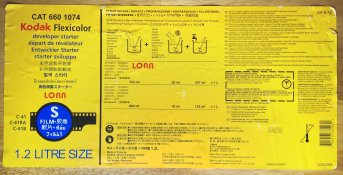 Kodak Flexicolor Developer Starter LORR 660-1074 Label.jpg767.8 KB · Views: 433
Kodak Flexicolor Developer Starter LORR 660-1074 Label.jpg767.8 KB · Views: 433 -
 Kodak Flexicolor Developer Starter LORR 660-1074.jpg157.5 KB · Views: 295
Kodak Flexicolor Developer Starter LORR 660-1074.jpg157.5 KB · Views: 295 -
 Kodak Flexicolor LU Developer Replenisher LORR 823-1672 Part A.jpg715.2 KB · Views: 402
Kodak Flexicolor LU Developer Replenisher LORR 823-1672 Part A.jpg715.2 KB · Views: 402 -
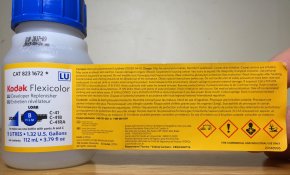 Kodak Flexicolor LU Developer Replenisher LORR 823-1672 Part B.jpg702.9 KB · Views: 714
Kodak Flexicolor LU Developer Replenisher LORR 823-1672 Part B.jpg702.9 KB · Views: 714 -
 Kodak Flexicolor LU Developer Replenisher LORR 823-1672 Part C.jpg862.3 KB · Views: 637
Kodak Flexicolor LU Developer Replenisher LORR 823-1672 Part C.jpg862.3 KB · Views: 637 -
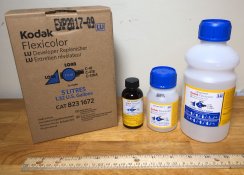 Kodak Flexicolor LU Developer Replenisher LORR 823-1672 Unboxed.jpg680.6 KB · Views: 397
Kodak Flexicolor LU Developer Replenisher LORR 823-1672 Unboxed.jpg680.6 KB · Views: 397 -
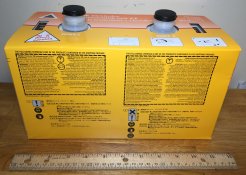 Kodak Flexicolor SM Processing Unit F2 v2.1 C-41SM 117-3319.jpg387.5 KB · Views: 223
Kodak Flexicolor SM Processing Unit F2 v2.1 C-41SM 117-3319.jpg387.5 KB · Views: 223 -
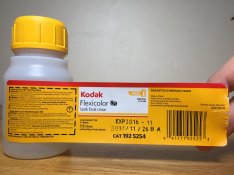 Kodak Flexicolor SM Tank Final Rinse C-41SM 192-5254 Label.jpg674.8 KB · Views: 375
Kodak Flexicolor SM Tank Final Rinse C-41SM 192-5254 Label.jpg674.8 KB · Views: 375 -
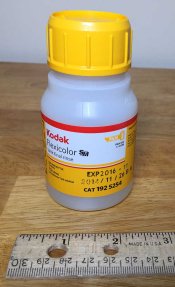 Kodak Flexicolor SM Tank Final Rinse C-41SM 192-5254.jpg77.5 KB · Views: 207
Kodak Flexicolor SM Tank Final Rinse C-41SM 192-5254.jpg77.5 KB · Views: 207 -
 Kodak Flexicolor LU Developer Replenisher LORR 823-1672 Box Pt1.jpg1.1 MB · Views: 253
Kodak Flexicolor LU Developer Replenisher LORR 823-1672 Box Pt1.jpg1.1 MB · Views: 253 -
 Kodak Flexicolor LU Developer Replenisher LORR 823-1672 Box Pt2.jpg1 MB · Views: 271
Kodak Flexicolor LU Developer Replenisher LORR 823-1672 Box Pt2.jpg1 MB · Views: 271 -
 Kodak Flexicolor SM Processing Unit F2 v2.1 C-41SM 117-3319 Box Pt2.jpg834.9 KB · Views: 240
Kodak Flexicolor SM Processing Unit F2 v2.1 C-41SM 117-3319 Box Pt2.jpg834.9 KB · Views: 240 -
 Kodak Flexicolor SM Processing Unit F2 v2.1 C-41SM 117-3319 Box Pt1.jpg955.7 KB · Views: 239
Kodak Flexicolor SM Processing Unit F2 v2.1 C-41SM 117-3319 Box Pt1.jpg955.7 KB · Views: 239
rpavich
Member
Thanks for doing that!
| Photrio.com contains affiliate links to products. We may receive a commission for purchases made through these links. To read our full affiliate disclosure statement please click Here. |
PHOTRIO PARTNERS EQUALLY FUNDING OUR COMMUNITY:  |









